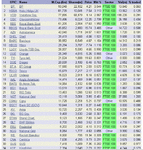barjon
Legendary member
- Messages
- 10,752
- Likes
- 1,863
Hi all,
A question that has bothered me for years.
Essentially ta is the study of supply & demand. In asides to some posts I have posed the question as to why ta works on an index since the index has no supply & demand of its own (you can't buy shares in an index) but merely reflects the aggregated supply & demand of its constituents. Thus, the share horses pull the index cart.
Supply & demand of an individual share is affected by market sentiment (the most important) and by factors distinct to that share. However, our gauge of market sentiment comes primarily from looking at what the index is doing. Thus, the index cart pulls the share horses.
A nifty paradox?
Does it matter?
Good trading
jon
A question that has bothered me for years.
Essentially ta is the study of supply & demand. In asides to some posts I have posed the question as to why ta works on an index since the index has no supply & demand of its own (you can't buy shares in an index) but merely reflects the aggregated supply & demand of its constituents. Thus, the share horses pull the index cart.
Supply & demand of an individual share is affected by market sentiment (the most important) and by factors distinct to that share. However, our gauge of market sentiment comes primarily from looking at what the index is doing. Thus, the index cart pulls the share horses.
A nifty paradox?
Does it matter?
Good trading
jon

